
Chinese Poem Coins

Emperor Kangxi of the Qing Dynasty
China enjoyed a long period of
peace and prosperity during the rule of Qing (Ch'ing) dynasty
Emperor Sheng Zu (1662-1722 AD). Emperor Sheng Zu is
better known by his reign title of Kang Xi (Kangxi 康熙)
which can also be written Kang Hsi or K'ang Hsi.
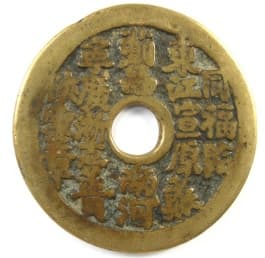 The Kangxi era is
also known for its cultural achievements which included the Kangxi Dictionary (kang xi zi dian 康熙子典)
published in 1716. This dictionary was the largest
compiled up to that time and contained more than 47,000
Chinese characters.
The Kangxi era is
also known for its cultural achievements which included the Kangxi Dictionary (kang xi zi dian 康熙子典)
published in 1716. This dictionary was the largest
compiled up to that time and contained more than 47,000
Chinese characters.
Emperor Kangxi is renown for his poetry. In 1696, he personally wrote the poems accompanying each of the twenty-three illustrations of a work entitled "Illustrations of Plowing and Weaving" (Gengzhi Tu 耕织 图) depicting the cultivation of rice and the rearing of silkworms. (Please see Men Plow, Women Weave.)
The Chinese traditional view of life was that a person should achieve his accomplishments in life and then retire at the age of 60. Emperor Kangxi actually reigned for 61 years which was the longest in Chinese history and one of the longest in world history.
Coin Mints of Emperor Kangxi
A total of twenty-three (23) coin mints operated during the reign of Emperor Kangxi. Several of these mints, however, closed and reopened at various times.
The cash coins produced at these mints became the standard for the Qing Dynasty. The coins are characterized by an obverse having the four character inscription kang xi tong bao (康熙通宝), meaning currency of Kang Xi.
The reverse side has a two character inscription. The name of the mint is written in Chinese to the right of the square hole.

To the left of the square hole, and displayed here, is the Manchu character boo which means "building". However, in the case of Qing Dynasty coins, the Manchu character boo is used as a transliteration of the Chinese character bao (宝) which means "treasure".
Coins cast with the Chinese characters kang xi (康熙) are considered particularly auspicious because kang (康) means "health" and xi (熙) means "prosperous".
Additionally, Emperor Kangxi reigned for more than 60 years. Besides representing a "long life", sixty years happens to be a complete cycle of the Chinese calendar which thus symbolizes "longevity". (Please visit Chinese Coins with Charm Features to see a special coin cast in 1713 AD to honor the 60th birthday of Emperor Kangxi.)
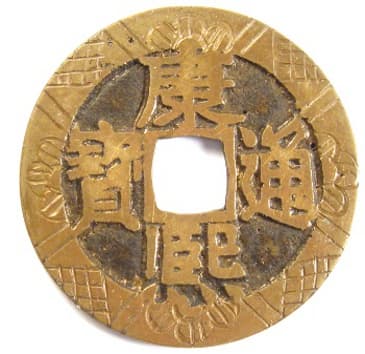
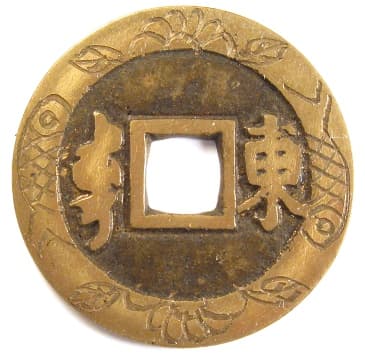 The coin at the
left is an example of a kang xi tong bao (康熙通宝) cash coin.
The coin at the
left is an example of a kang xi tong bao (康熙通宝) cash coin.
The reverse side (near left) has the Chinese character "east" (dong 东) meaning that it was cast at the mint in Jinan, Shandong Province.
This particular coin has been embellished with engravings on the rims.
The engraved symbols on the reverse side include two fish with one on the right and one on the left side of the rim.
The fish is considered a very auspicious symbol. The Chinese character for fish (yu 鱼) has the same pronunciation as the word for "abundance" (yu 余).
Also, two fish or a pair of fish (shuang yu 双鱼) symbolize happiness in marriage.
Because the reign of Emperor Kangxi is associated with peace, prosperity and longevity, people gradually developed a custom to collect a coin cast from each of twenty mints, put them on a string in a certain order, and then carry for "good luck".
The coins were put in a specific order to form a "poem". Even though the "poem" did not have any particular meaning, it did rhyme according to the rules of classical Chinese poetry.
These "poem coins" (shi qian 诗钱) were considered to have charm and amulet properties. When strung together in the proper order they are known as "set coins" (taozi qian 套子钱).
According to F. Schjoth in Chinese Currency (London, 1929): "If genuine and placed together, they have the power of expelling evil influences and of preventing fires. Their genuineness according to popular belief can be tested by placing them, when strung together, on the top of a chicken-coop: if genuine, they will prevent the cocks from crowing in the morning!".
Since carrying a string of twenty coins as a "charm" was not very convenient, single coins began to be cast with ten of the mint names on one side and ten mint names on the other side.
Coins cast by the central government at the "Board of Revenue" and the "Board of Works" mints in Beijing (Peking) were not included in the poem. Also, coins from the Gongchang mint in Gansu Province were not included, perhaps because very few were actually cast.
Names of the Twenty Mints of
the Poem Coins
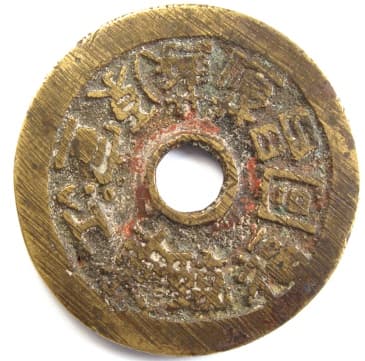
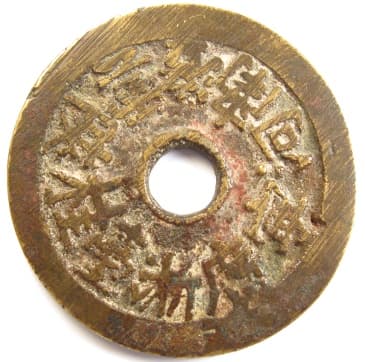 The
majority of poem charm coins are round with a round center
hole and only display the twenty
mint names mentioned above from the reign of Emperor
Kangxi.
The
majority of poem charm coins are round with a round center
hole and only display the twenty
mint names mentioned above from the reign of Emperor
Kangxi.
Here is an example of such a poem charm.
The obverse side (far left) includes the names of the first ten of the twenty mints mentioned above.
The reverse side (near left) includes the last ten of the mint names.
You may notice that parts of this charm have a red tinge. Red is considered a very auspicious color by the Chinese who like to enhance the amuletic effect of charms with the addition of red paint.
This Kangxi poem charm has a diameter of 42 mm and a weight of 20.7 grams.
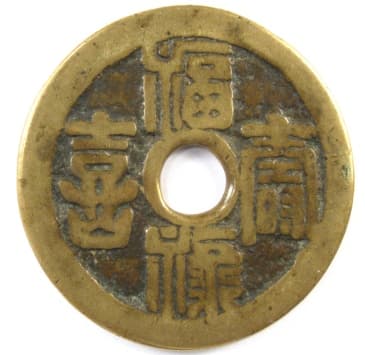
A very few poem coins, however, also include an auspicious inscription or saying such as would be found on a charm.
This is a very nice example of a coin having a charm inscription as well as the names of the twenty mints of the Kangxi era set in the form of a poem.
The obverse side of the charm, seen at the left, has the four character inscription, read top to bottom and right to left, fu lu shou xi (福禄寿喜) which means "good fortune, emolument (official salary), longevity and happiness".
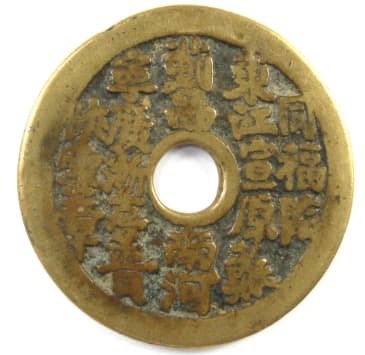
The reverse side displays the names of the twenty Kangxi mints in the form of a poem.
The names of the coin mints are always written in the specific order explained above.
On this charm, however, the mint names are written in vertical columns starting from the right.
This charm has a diameter of 44.5 mm and a weight of 21 grams.
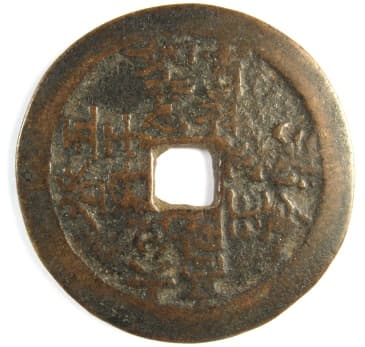 This is a fairly rare
example of a poem charm. It is a little difficult to read
but its condition and characteristics are typical of a
charm cast at the mint in Yunnan Province.
This is a fairly rare
example of a poem charm. It is a little difficult to read
but its condition and characteristics are typical of a
charm cast at the mint in Yunnan Province.
Besides being rare, it is unusual in that the obverse side has not one but four separate inscriptions (legends).
Each of the four inscriptions consists of four characters written as two pairs. Each four-character legend is read in the following order: top right, bottom right, top left, bottom left. To conveniently read each inscription, you should actually rotate the charm so that you are always reading the inscription above the hole.
In the view to the left, the inscription above the square hole is ji xiang ru yi (吉祥如意) which means "may your good fortune be according to your wishes".
To the right of the square hole is the legend jin yu man tang (金玉满堂) which means "may gold and jade fill your halls".
Below the square hole is the legend da wei gao sheng (大位高升) which translates as "may you be promoted to a high position".
To the left of the square hole is the inscription wu zi deng ke (五子登科) which means "may your five sons achieve great success in the imperial examinations". (The ideal family according to Confucian standards included five sons and two daughters.)
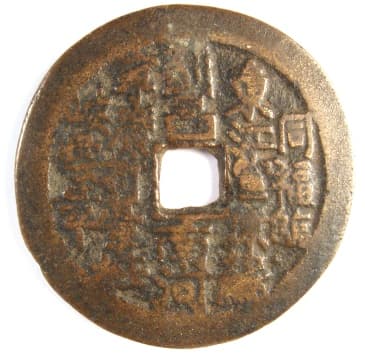
In the same manner as the charm above, the reverse side of this charm displays the names of the 20 coin mints of the reign of Emperor Kangxi in the set order.
The charm has a diameter of 46 mm and weight of 27.6 grams.
Return to Ancient Chinese Charms and Coins
 The Kangxi era is
also known for its cultural achievements which included the Kangxi Dictionary (kang xi zi dian 康熙子典)
published in 1716. This dictionary was the largest
compiled up to that time and contained more than 47,000
Chinese characters.
The Kangxi era is
also known for its cultural achievements which included the Kangxi Dictionary (kang xi zi dian 康熙子典)
published in 1716. This dictionary was the largest
compiled up to that time and contained more than 47,000
Chinese characters.Emperor Kangxi is renown for his poetry. In 1696, he personally wrote the poems accompanying each of the twenty-three illustrations of a work entitled "Illustrations of Plowing and Weaving" (Gengzhi Tu 耕织 图) depicting the cultivation of rice and the rearing of silkworms. (Please see Men Plow, Women Weave.)
The Chinese traditional view of life was that a person should achieve his accomplishments in life and then retire at the age of 60. Emperor Kangxi actually reigned for 61 years which was the longest in Chinese history and one of the longest in world history.
Coin Mints of Emperor Kangxi
A total of twenty-three (23) coin mints operated during the reign of Emperor Kangxi. Several of these mints, however, closed and reopened at various times.
The cash coins produced at these mints became the standard for the Qing Dynasty. The coins are characterized by an obverse having the four character inscription kang xi tong bao (康熙通宝), meaning currency of Kang Xi.
The reverse side has a two character inscription. The name of the mint is written in Chinese to the right of the square hole.

To the left of the square hole, and displayed here, is the Manchu character boo which means "building". However, in the case of Qing Dynasty coins, the Manchu character boo is used as a transliteration of the Chinese character bao (宝) which means "treasure".
Coins cast with the Chinese characters kang xi (康熙) are considered particularly auspicious because kang (康) means "health" and xi (熙) means "prosperous".
Additionally, Emperor Kangxi reigned for more than 60 years. Besides representing a "long life", sixty years happens to be a complete cycle of the Chinese calendar which thus symbolizes "longevity". (Please visit Chinese Coins with Charm Features to see a special coin cast in 1713 AD to honor the 60th birthday of Emperor Kangxi.)

 The coin at the
left is an example of a kang xi tong bao (康熙通宝) cash coin.
The coin at the
left is an example of a kang xi tong bao (康熙通宝) cash coin.The reverse side (near left) has the Chinese character "east" (dong 东) meaning that it was cast at the mint in Jinan, Shandong Province.
This particular coin has been embellished with engravings on the rims.
The engraved symbols on the reverse side include two fish with one on the right and one on the left side of the rim.
The fish is considered a very auspicious symbol. The Chinese character for fish (yu 鱼) has the same pronunciation as the word for "abundance" (yu 余).
Also, two fish or a pair of fish (shuang yu 双鱼) symbolize happiness in marriage.
Because the reign of Emperor Kangxi is associated with peace, prosperity and longevity, people gradually developed a custom to collect a coin cast from each of twenty mints, put them on a string in a certain order, and then carry for "good luck".
The coins were put in a specific order to form a "poem". Even though the "poem" did not have any particular meaning, it did rhyme according to the rules of classical Chinese poetry.
These "poem coins" (shi qian 诗钱) were considered to have charm and amulet properties. When strung together in the proper order they are known as "set coins" (taozi qian 套子钱).
According to F. Schjoth in Chinese Currency (London, 1929): "If genuine and placed together, they have the power of expelling evil influences and of preventing fires. Their genuineness according to popular belief can be tested by placing them, when strung together, on the top of a chicken-coop: if genuine, they will prevent the cocks from crowing in the morning!".
Since carrying a string of twenty coins as a "charm" was not very convenient, single coins began to be cast with ten of the mint names on one side and ten mint names on the other side.
Coins cast by the central government at the "Board of Revenue" and the "Board of Works" mints in Beijing (Peking) were not included in the poem. Also, coins from the Gongchang mint in Gansu Province were not included, perhaps because very few were actually cast.
Names of the Twenty Mints of
the Poem Coins
The names of the twenty
Kangxi cash coin mints are always placed in the following
order to create the poem:
同福临东江 Tong Fu Lin Dong Jiang
宣原苏蓟昌 Xuan Yuan Su Ji Chang
南宁河广浙 Nan Ning He Guang Zhe
台桂陕云漳 Tai Gui Shan Yun Zhang
The Chinese characters in the poem refer to the following twenty (20) coin mints:
同福临东江 Tong Fu Lin Dong Jiang
宣原苏蓟昌 Xuan Yuan Su Ji Chang
南宁河广浙 Nan Ning He Guang Zhe
台桂陕云漳 Tai Gui Shan Yun Zhang
The Chinese characters in the poem refer to the following twenty (20) coin mints:
| Chinese | Pronunciation |
Location |
| 同 | tong |
Datong, Shanxi
Province |
| 福 | fu |
Fuzhou, Fujian
Province |
| 临 | lin |
Linqing, Shandong
Province |
| 东 | dong |
Jinan, Shandong
Province |
| 江 | jiang |
Nanchang, Jiangxi
Province |
| 宣 | xuan |
Xuanhua, Zhili
(Hebei) Province |
| 原 | yuan |
Taiyuan, Shanxi
Province |
| 苏 | su |
Suzhou, Jiangsu
Province |
| 蓟 | ji |
Jizhou, Zhili (Hebei)
Province |
| 昌 | chang |
Wuchang, Hubei
Province |
| 南 | nan |
Changsha, Hunan
Province |
| 宁 | ning |
Historical records
unclear. Probably refers to Nanjing
(Jiangning), Jiangnan Province but could be Ningxia,
Gansu Province |
| 河 | he |
Kaifeng, Henan
Province |
| 广 | guang |
Guangzhou, Guangdong
Province |
| 浙 | zhe |
Hangzhou, Zhejiang
Province |
| 台 | tai |
Taiwan Province |
| 桂 | gui |
Guilin, Guangxi
Province |
| 陕 | shan |
Xian, Shaanxi
Province |
| 云 | yun |
Yunnan Province |
| 漳 | zhang |
Zhangzhou, Fujian
Province |
Poem Charms

 The
majority of poem charm coins are round with a round center
hole and only display the twenty
mint names mentioned above from the reign of Emperor
Kangxi.
The
majority of poem charm coins are round with a round center
hole and only display the twenty
mint names mentioned above from the reign of Emperor
Kangxi.Here is an example of such a poem charm.
The obverse side (far left) includes the names of the first ten of the twenty mints mentioned above.
The reverse side (near left) includes the last ten of the mint names.
You may notice that parts of this charm have a red tinge. Red is considered a very auspicious color by the Chinese who like to enhance the amuletic effect of charms with the addition of red paint.
This Kangxi poem charm has a diameter of 42 mm and a weight of 20.7 grams.

A very few poem coins, however, also include an auspicious inscription or saying such as would be found on a charm.
This is a very nice example of a coin having a charm inscription as well as the names of the twenty mints of the Kangxi era set in the form of a poem.
The obverse side of the charm, seen at the left, has the four character inscription, read top to bottom and right to left, fu lu shou xi (福禄寿喜) which means "good fortune, emolument (official salary), longevity and happiness".

The reverse side displays the names of the twenty Kangxi mints in the form of a poem.
The names of the coin mints are always written in the specific order explained above.
On this charm, however, the mint names are written in vertical columns starting from the right.
This charm has a diameter of 44.5 mm and a weight of 21 grams.
 This is a fairly rare
example of a poem charm. It is a little difficult to read
but its condition and characteristics are typical of a
charm cast at the mint in Yunnan Province.
This is a fairly rare
example of a poem charm. It is a little difficult to read
but its condition and characteristics are typical of a
charm cast at the mint in Yunnan Province.Besides being rare, it is unusual in that the obverse side has not one but four separate inscriptions (legends).
Each of the four inscriptions consists of four characters written as two pairs. Each four-character legend is read in the following order: top right, bottom right, top left, bottom left. To conveniently read each inscription, you should actually rotate the charm so that you are always reading the inscription above the hole.
In the view to the left, the inscription above the square hole is ji xiang ru yi (吉祥如意) which means "may your good fortune be according to your wishes".
To the right of the square hole is the legend jin yu man tang (金玉满堂) which means "may gold and jade fill your halls".
Below the square hole is the legend da wei gao sheng (大位高升) which translates as "may you be promoted to a high position".
To the left of the square hole is the inscription wu zi deng ke (五子登科) which means "may your five sons achieve great success in the imperial examinations". (The ideal family according to Confucian standards included five sons and two daughters.)

In the same manner as the charm above, the reverse side of this charm displays the names of the 20 coin mints of the reign of Emperor Kangxi in the set order.
The charm has a diameter of 46 mm and weight of 27.6 grams.
Return to Ancient Chinese Charms and Coins